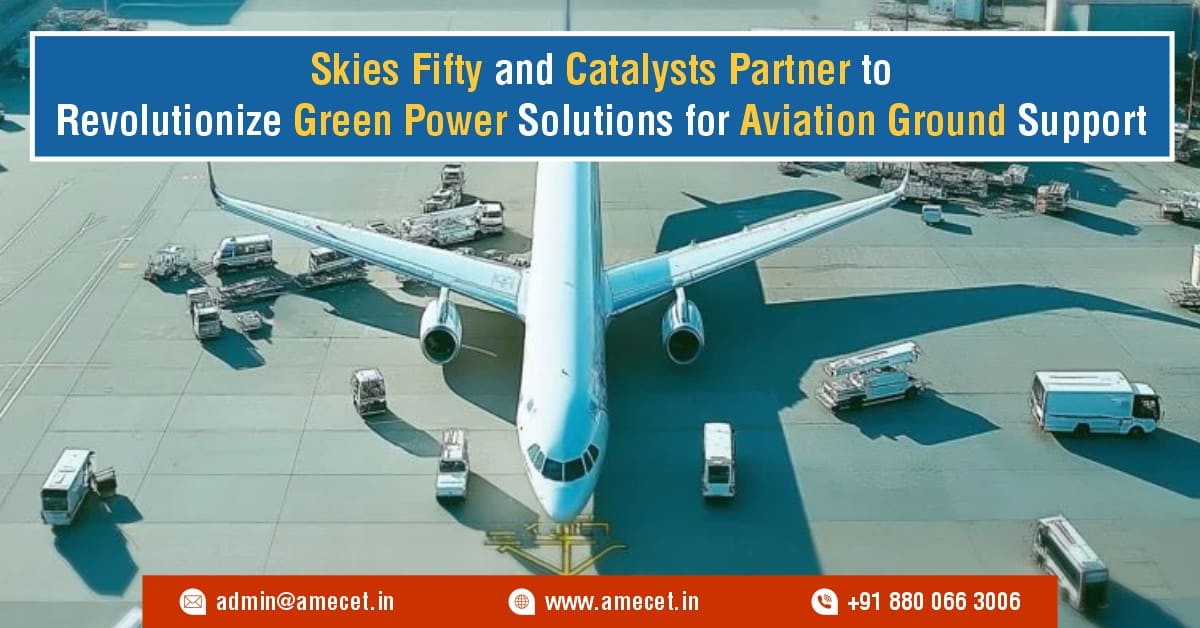
The aviation industry, known for its significant environmental impact, is now witnessing an important shift towards sustainability. In a groundbreaking move that promises to reshape airport operations, SkiesFifty and Catalsys have announced a strategic partnership aimed at introducing green power solutions for aviation ground support. This collaboration marks a critical step in transforming ground support services, leveraging innovative technologies to reduce carbon emissions and make airport operations more sustainable. The partnership aims to develop and implement electric and hydrogen-powered systems to replace traditional fossil fuel-based ground support equipment (GSE), a move that could revolutionize the way airports operate worldwide.
A Sustainable Future for Airport Ground Operations
Ground support equipment (GSE) plays a vital role in airport operations, assisting in the maintenance of aircraft and ensuring smooth transitions between arrivals and departures. GSE includes a wide array of vehicles and machinery such as tugs, conveyor belts, ground power units (GPUs), and pushback tractors, all of which are crucial for the efficient functioning of the airport. However, these operations have traditionally relied heavily on fossil fuels, contributing to carbon emissions and air pollution at airports.
The partnership between SkiesFifty and Catalsys aims to transition these ground support operations to more sustainable power sources. By introducing green power solutions, including electric and hydrogen-powered alternatives, the collaboration hopes to reduce the dependency on diesel and other harmful fuels. This shift is not only environmentally friendly but also aligns with the growing trend towards sustainability in the aerospace sector.
The Role of Aircraft Maintenance and Engineering in Sustainable Aviation
Sustainability in aviation isn't just limited to aircraft design and manufacturing. A significant aspect of creating a greener aviation sector is improving the sustainability of aircraft maintenance and the operations that support the aircraft throughout their life cycle. Aircraft engineers and aircraft maintenance engineers are at the forefront of this transition. Their expertise ensures that aircraft are maintained to the highest standards, using eco-friendly practices and technologies.
The green power solutions developed by SkiesFifty and Catalsys will have direct implications for aircraft maintenance engineering. By reducing the reliance on fossil fuel-powered GSE, the need for regular maintenance of traditional internal combustion engines used in these vehicles will decrease. This reduction in mechanical complexity will allow aircraft maintenance engineers to focus more on integrating sustainable practices into aircraft upkeep, thereby aligning with the broader goals of sustainability within the aviation sector.
Training and Education for a Green Aviation Future
As airports and airlines transition to sustainable ground support solutions, airport ground staff training becomes increasingly important. Airport ground staff are responsible for handling and maintaining the GSE, and with the introduction of electric and hydrogen-powered equipment, there will be a need for specialized training. This new generation of airport ground staff will need to be equipped with the skills necessary to operate and maintain these advanced green technologies.
Aerospace engineering courses and aircraft maintenance engineering courses will play a pivotal role in this transition. By incorporating sustainable technologies and green power systems into the curriculum, educational institutions can better prepare students for the challenges of tomorrow’s aviation sector. Future aircraft maintenance engineers will be trained in the latest technologies to ensure they can effectively work with electric and hydrogen-powered systems, promoting further innovation in the sector.
Furthermore, aircraft manufacturers will need to adapt their designs to accommodate new power systems for GSE. These manufacturers play a crucial role in creating the hardware needed for the transition to green power, and their involvement in the development of new electric and hydrogen-powered equipment will be essential for the success of the initiative.
Commercial Aircraft Manufacturers and Sustainability
The involvement of commercial aircraft manufacturers in this sustainable shift is critical. While the aircraft themselves are already subject to rigorous standards for fuel efficiency and carbon emissions, the ground support systems that serve these aircraft are often overlooked. By integrating electric and hydrogen technologies into GSE, manufacturers can help create a more sustainable ecosystem for aviation, enhancing the environmental performance of the entire airport infrastructure.
This partnership between SkiesFifty and Catalsys serves as a prime example of how innovation in ground support can complement broader goals in aviation sustainability. As aircraft manufacturers continue to focus on designing more energy-efficient aircraft, airport ground systems will also need to evolve to meet these new standards.
The Role of Pilot Training in a Sustainable Aviation Ecosystem
While ground support operations are undergoing a green revolution, pilot training is also adapting to the changing landscape of aviation. Commercial pilot training programs are already incorporating aspects of sustainability into their curriculums, with a focus on fuel-efficient flying techniques and an understanding of eco-friendly aviation technologies. As commercial pilots become more knowledgeable about green aviation practices, they will be better equipped to make informed decisions that contribute to a more sustainable flight experience.
The integration of green power solutions into aviation ground support will further enhance these efforts. With cleaner ground operations and sustainable fueling practices, pilots will benefit from a more efficient and environmentally conscious operational framework.
The Future of Green Power in Aviation: A Collaborative Effort
The partnership between SkiesFifty and Catalsys is a significant milestone in the aviation industry's push toward sustainability. The collaboration highlights the importance of working together—across sectors, from aircraft maintenance and engineering to airport ground staff training and commercial pilot training—to build a greener aviation ecosystem. By working together, these organizations can help reduce carbon emissions, improve air quality around airports, and foster a more sustainable future for the entire aviation industry.
For countries like India, where airlines such as Air India Express are crucial to connecting regions and promoting economic growth, these advancements in green power solutions will help ensure the industry can continue to expand while minimizing its environmental footprint. The efforts of SkiesFifty and Catalsys, along with other industry players, can set a precedent for aviation maintenance engineering worldwide, enabling countries to move towards more sustainable aviation practices and cutting-edge technology.
Ultimately, as aircraft engineers, airport ground staff, and commercial pilots work together, they will ensure that aviation remains a key pillar of global connectivity, all while reducing its impact on the environment. By prioritizing green power solutions in aviation ground support, the sector is taking an important step toward a more sustainable future
Category
-
Aircraft Maintenance Engineering (DGCA) (55)
-
Cabin Crew (1)
-
Aircraft Maintenance Engineer (AME) (1)
-
Aerospace Engineering (3)
-
Commercial Pilot License(CPL) (81)
-
(188)
-
Aircraft Maintenance Engineering (BTech/BE) (4)
-
Aeronautical Engineering (2)
-
Airport Management (5)
-
Aircraft Maintenance Engineering (EASA) (11)
-
Airport Ground Staff (1)
-
B.Sc. in Aviation (1)
-
AME CET (5)
